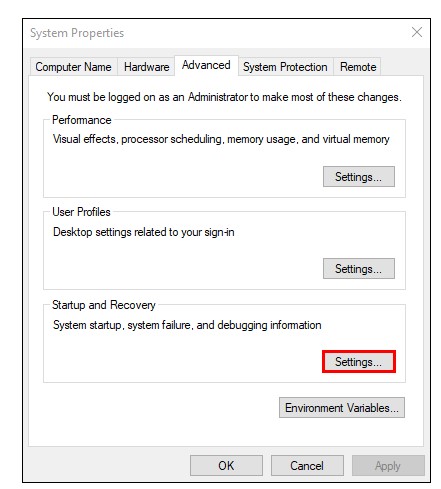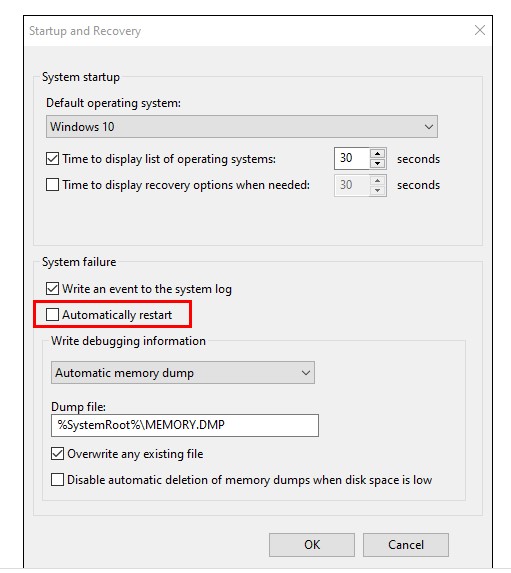If you’re a regular PC or laptop user, there may be nothing as annoying as your device restarting on its own periodically. This is not only unpleasant, but it also causes you to lose important work in progress.
If you’re having trouble restarting your computer and want answers, you’ve come to the right place. This article will share tips for resolving Windows 10, 7 and Mac issues. Learn how to easily gain control of your device.

If you restart Windows 10 once you open the program, don’t worry. Many users have encountered the same problem. Below are the most common fixes for Windows 10 random restart.
Method 1: Disable the Automatically Restart Feature
Windows 10 has the in-built feature of the auto-restart the computer to tackle application failures and other errors. However, if you are facing the problem of a repetitive system restart, this feature can be easily disabled.
Before moving forward to know how to disable the automatic restart option, you have to keep one thing in mind that once this option is disabled, the next time your system experience a failure, it will not be able to restart and would freeze, show a distorted image, or just blue or black screen. So, remember to re-enable the automatic restart option once the system starts..
From the windows search box, search, and open Control Panel.
- Enter “This PC/My Computer/computer” into the search box next to “Start.”
- Right-click on the result.
- Go to “Properties.”
- Go to “Advanced system settings” and then to “Settings”.

- Switch off the “Auto Restart” function and press “OK”.

You have now disabled the feature that makes your computer restart randomly. Continue working on your PC to see if the issue is solved.
Method 2: Update BIOS
- The first step is to identify the BIOS version. To do this, press Windows + R, then type “msinfo32” (without the quotation marks) and press Enter to open System Information.
- When the System Information window opens, find the BIOS version / date and enter the BIOS manufacturer and version.
- Next, go to your manufacturer’s website, and then enter the serial number of my computer or click on the automatic detection option.
- Now click on the BIOS from the displayed list of drivers and download the recommended update.
Note: Do not turn off the computer or turn off the power when updating the BIOS, otherwise you may damage the computer. During the update, your computer will restart and you will see a black screen for a while.
- Once the file is downloaded, just double click on the Exe file and download it.
- Finally, you have updated your BIOS and may also accidentally restart the Repair Computer in case of a problem with Windows 10.
Method 3 : Apply Troubleshooting in Safe Mode
It’s possible that the startup problem was also caused by an application or system error. Therefore, you may not be able to use the troubleshooting options in normal mode. Therefore, restart the system in safe mode before you take action. Therefore, follow these instructions:
- Click the Windows Start icon.
- Press and hold the left Shift key on the keyboard.
- Click the Power icon, then select Restart and press Shift.
- Finally, release the Shift key when the system restarts. The system restarts safely.
Method 4: Disable Fast Startup
The Windows Quick Start feature allows you to start faster each time you restart your system after it crashes. It is possible that a quick boot is causing your system problems, so the restart continues. It is better to disable the quick scan and see if the problem persists.
- Open Control Panel by finding it in the Windows search bar.
- Bring hardware and sound Hardware and sound.
- Click Power Options in the right pane.
- Click “Choose what to do with the power buttons.”
- Now click on “Change settings that are not currently available” to activate the settings.
- Deselect Disable Settings to enable Quick Launch to disable Quick Launch.
Method 5. Uninstall latest installed apps
You may have recently installed an application that could interfere with your computer and cause multiple startups. Some applications may change system settings and functions. It is therefore advisable to grab the root application and remove it from the system. You can do this as follows:
- Open Control Panel and click Uninstall a program.
- Sort the applications in order of installation date. Select the application responsible for the problem and uninstall it.
- There can be many applications that cause problems; you can remove them all from each other.
Method 6: Uninstall latest Windows updates
Sometimes Windows updates may be installed incorrectly and may cause the computer to restart constantly. The solution is to remove the latest updates. To do this, follow these steps:
- Go to Windows Settings-> Updates and Security.
- Click View update history.
- In the next window, click Uninstall updates.
- Check for the latest updates after your system starts troubleshooting.
- Select it and click Uninstall. If there are multiple updates that are causing the issues, you can remove each one and then reinstall it.
Method 7: Tweak the Power Settings
Another reason why the computer may restart is incorrect power settings. Here’s how to reconfigure the settings to fix the problem:.
- Enter “Power Options” in the search box in Windows 10.

- Select “Edit power plan” or similar items in the power settings.
- Select “Change power settings”.
- Stay in the “Balance” section and click on “Manage Processor Power”.
- Select “Minimum CPU Status” and set it to 5% or even 0%.
- Click “Apply” and then “OK.”
If the computer continues to restart after adjusting the power options, go to the next section.
Method 8: Check for Overheating
If your computer overheats, it may start accidentally. You can control the computer temperature using the BIOS or third-party software. In addition, your appliance may need some air pressure or dust cleaning to clean the openings or other openings of dirt.
Method 9: Inspect Your Computer for Hardware Issues
If none of the above suggestions work, a hardware problem may cause you to start randomly. Check the CPU or central power supply to make sure it is in perfect condition. If your laptop or computer is still under warranty, have it checked by a local service center.
Method 10: Reset Windows to the earlier System Restore Point
Windows has a good function in the form of a system restore point. Here, users can restore the system to the last restore point if the system is not working properly. Restore points are automatically created by the operating system when you install a new update or application. Restoring Windows to a previous point will not affect your personal files and data. To restore Windows, follow these steps:
- Search for “rstrui” in the windows search bar and click on its icon to open it.
- Click on Next to continue.
- Choose the restore point where your system was working properly and click next.
- Follow the on-screen instructions to restore the system to your desired point.
Method 11: Scan your system for malware
A malware attack can also cause a system error, resulting in an ongoing startup problem. It can infect your system, corrupt many files and disable many features.
If your system is not equipped with anti-malware, it’s a good idea to get a strong security solution, such as Malwarebytes, and perform an in-depth system scan.
Check CPU
When it warms up, the processor inside the CPU can slow down the system and cause system operation problems. Make sure the processor fan is working properly to cool the processor. Also clean dust from the processor
What is the blue screen error?
A blue screen error can occur if a problem causes your device to shut down or restart unexpectedly. You might see a blue screen with a message that your device ran into a problem and needs to be restarted.
Conclusion:
These are all possible fixes that your computer could fix and that would cause the problem to restart. If the problem persists after performing all the fixes, it is a good idea to install Windows recently. You can also check your system with service center experts.
